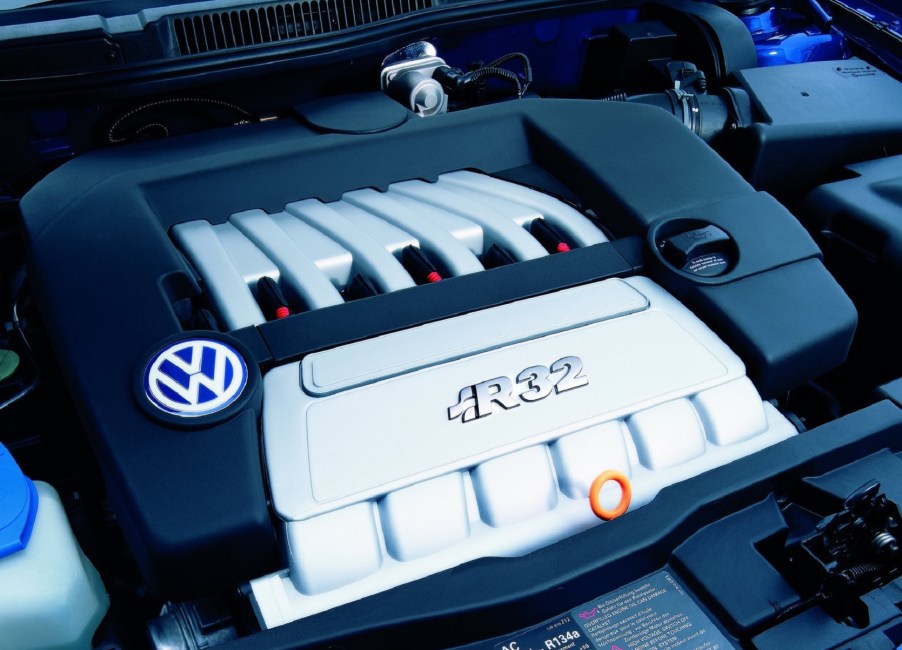
With a Few Tweaks, the VR6 Is a More Reliable Volkswagen Engine
Reliability and durability, though related, aren’t the same thing where maintenance is concerned. After all, if you have to constantly replace parts of your engine for it to work, that’s not a reliable engine. However, sometimes durable powerplants just need a few modifications or upgrades to make them easier to live with. Such is the case with the Volkswagen VR6 engine.
The VR6 is a special engine for Volkswagen fans
Although it’s been superseded by lighter, smaller, and more efficient turbocharged powerplants, the Volkswagen VR6 was a “pretty revolutionary” engine, Road & Track reports. Like a V6, it has two banks of three cylinders, DriveTribe explains. However, unlike a conventional V6, the Volkswagen VR6 only has one cylinder head.
This arrangement let Volkswagen put V6 power in cars that could only fit four-cylinder engines, R&T explains. Not only could it fit in the small engine bays, but it also didn’t affect weight distribution as much as a ‘normal’ V6 would. So, you got more power without messing up the handling.

The first 2.8-liter VR6 engine appeared in the 1992 Volkswagen Corrado and contemporary Passat, Drifted reports. It later made its way to cars like the Jetta, the Mk4 Golf GTI, the Phaeton, and even the Touareg and Atlas. But arguably the most iconic version is in the 2004 and 2008 Golf R32. These AWD hot hatches have 3.2-liter VR6 engines, with 240 hp in the 2004 car and 250 hp in the 2008 car. And an engine note that Automobile describes as a “sweet, burbling aria.”
But Volkswagen didn’t just use the VR6 in VW-badged cars. The engine eventually found its way into the Porsche Cayenne as well as the Audi TT, A3, and Q7, EnginesWork reports. And the VR6 forms the basis of the Bentley Continental GT’s W12 engine, R&T reports. Even the Bugatti W16 engine makes use of ‘VR’ tech, DriveTribe reports.
Although durable, the Volkswagen VR6 has some reliability problems
Though it’s no longer on the cutting edge of engine design, the Volkswagen VR6 can be a durable engine, VW Tuning reports. However, it’s not without its faults.
A common complaint revolves around the ignition system. Early VR6s have coil packs, while later models use ignition coils, VW Tuning reports. And based on numerous forum threads on places like VW Vortex and r/Volkswagen, the VR6 seems prone to ignition coil and coil pack failure. Engines Work and VW Tuning back up these claims.
The NHTSA also has one complaint from a 2004 R32 owner who claims their car’s coil pack caught fire while driving on the expressway. Though it’s worth pointing out that the R32 has ignition coils, not a coil pack.
The Volkswagen VR6 also has some heat-related issues. The engine’s water pump has several plastic parts that degrade and break over time, VW Tuning reports. Also, the plastic coolant pipe is reportedly so notorious for breaking that it’s colloquially referred to as the “crack pipe,” EuroWise reports. This might be partially due to the tight confines of the engine bay, Griffins Auto Repair muses. Plus, if the engine does overheat, that can cause head gasket failure, another age-related VR6 issue, DustRunners Auto reports. Also, it can cause a ‘warm-stall’ phenomenon.
Additionally, the Volkswagen VR6 has some problems with its serpentine belt tensioner and timing chain, Drifted and VW Tuning report. But it’s less of a flaw and more of an age-related development. While timing chains generally last longer than belts, they do need to be replaced eventually. It’s a similar story with the serpentine belt and tensioner.
Luckily, most of these issues are fixable today
The good news is that none of these problems are necessarily deal-breakers. In the case of the Volkswagen VR6’s chain and belt, those are wear items in many engines. Just follow the maintenance schedule and monitor your engine.
Regarding the ‘crack pipe’ and water pump, websites like Gruven Parts offer aftermarket metal versions of these parts. And it’s worth pointing out that radiators and their various hoses do eventually need replacement.
As for the coil packs and ignition coils, Volkswagen issued a recall for the 2.8-liter VR6s, Consumer Affairs reports. As for the other engines, the NHTSA investigated the issue, but did not issue a recall, VW Problems reports. However, Volkswagen has since revised the ignition coils multiple times, the NHTSA and ECS Tuning report. Multiple VW Vortex forum users claim these new parts don’t fail like the earlier ones.
Finally, the ‘warm stall’ issue has been addressed via a Volkswagen TSB. All that’s needed is an ECU reflash to update the software, the NHTSA and VW Tuning report.
Naturally, if you’re considering buying a used Volkswagen with a VR6, we recommend getting a pre-purchase inspection. But with a few tweaks, it can be both a durable and a reliable engine.
Follow more updates from MotorBiscuit on our Facebook page.


